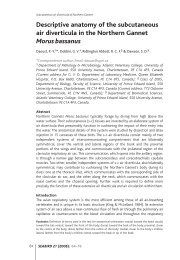Create successful ePaper yourself
Turn your PDF publications into a flip-book with our unique Google optimized e-Paper software.
172 I. LANGSETH ET AL. Atlantic <strong>Seabird</strong>s 3(4)<br />
BMR-residuals (%)<br />
150<br />
140<br />
130<br />
120<br />
110<br />
100<br />
90<br />
80<br />
70<br />
-30 -20 -10 0 10 20 30 40<br />
Days after hatching<br />
Figure 2. Relationship between the residuals of the regression of whole-body BMR and<br />
body mass (equation 1) and days after hatching of breeding female Blacklegged<br />
Kittiwakes (n = 40, linear regression: R = -0.47, df = 38, P = 0.002).<br />
Figuur 2. Het verband tussen de residuen van de regressie van BMR en massa (formule<br />
1) en het aantal dagen na het uitkomen van de jongen bij broedende wijfjes<br />
Drieteenmeeuwen (n = 40; lineaire regressie R = -0.47, df = 38, P = 0.002).<br />
available for self-maintenance. <strong>The</strong> result is a decrease in parental body mass.<br />
During the last part of the chick-rearing period the chicks can be left alone for<br />
longer periods and, even though their total energy demand increases, more time<br />
is available to provide for the adults’ own maintenance requirements. <strong>The</strong> result<br />
is that the adult body masses level off. <strong>The</strong> body mass changes of the female<br />
Black-legged Kittiwakes observed in the present study agrees with the findings<br />
of Moe et al. (2001) and of Wendeln & Becker (1996) in Common Terns Sterna<br />
hirundo.<br />
From the time of capture in the field until the BMR measurements were<br />
made in the laboratory, the body masses of the females decreased by<br />
approximately 9%. This was mainly due to emptying of the gut during the<br />
fasting period. <strong>The</strong> degree of body mass reduction was similar in all five groups<br />
and the changes in the lab body masses, in consequence, showed the same<br />
pattern of change as the field body masses.








